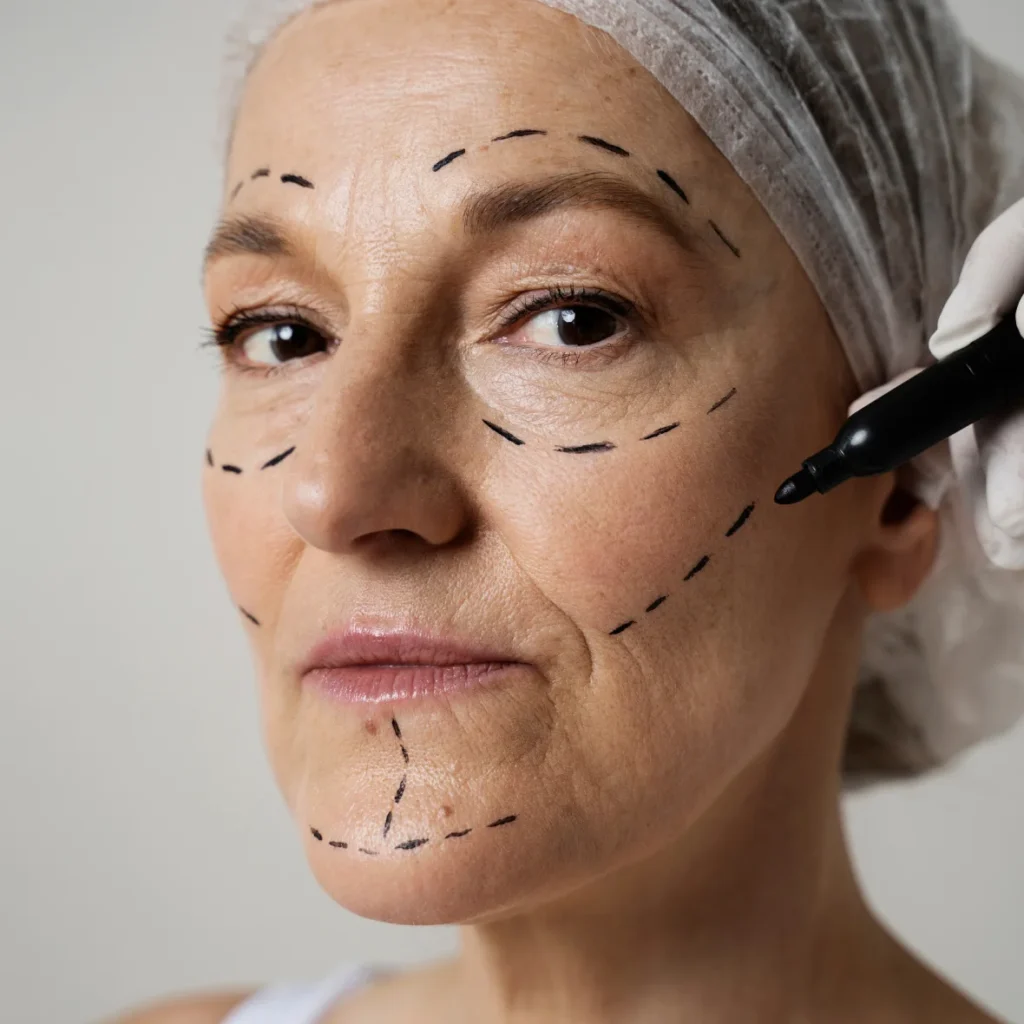Facelift surgery have become increasingly popular as people seek to maintain a youthful appearance. This surgical procedure can significantly reduce the visible signs of aging, such as sagging skin, wrinkles, and jowls.
What is a Facelift?
A facelift, also known as a rhytidectomy, is a surgical procedure that addresses facial aging by lifting and tightening the facial skin and underlying tissues. It can help to:
- Reduce sagging skin – Lift and tighten the skin on the cheeks, jawline, and neck.
- Improve facial contours – Restore a more youthful and defined facial shape.
- Minimize wrinkles – Smooth out wrinkles and creases.
Who is a Good Candidate for this surgery?
Ideal candidates for this surgery are generally in good overall health and have realistic expectations about the procedure. They typically
- Have noticeable sagging skin in the face and neck.
- Have moderate to severe wrinkles.
- Are non-smokers.
- Have a healthy lifestyle.
What to Expect from this surgery
The facelift procedure typically involves
- Incisions – Incisions are made in the hairline, around the ears, and under the chin.
- Tissue lifting – The underlying tissues are lifted and tightened.
- Excess skin removal – Excess skin is removed and the remaining skin is carefully draped.
- Closure – The incisions are closed with sutures or surgical glue.
Recovery from this procedure typically takes several weeks. Swelling and bruising are common during the initial recovery period. Most patients can return to work and social activities within a few weeks.
Benefits of a Facelift
- Improved appearance – A more youthful and refreshed appearance.
- Increased self-confidence – A boost in self-esteem and confidence.
- Long-lasting results – The results of a facelift can last for many years.
It’s important to consult with a qualified plastic surgeon to discuss your specific needs and goals. They can help you determine if a facelift is right for you and provide you with more information about the procedure and recovery process.
there’s and number of different types of facelifts which include
Types of Facelifts
There are several types of facelifts available, each tailored to address specific concerns and achieve different results. Here’s a brief overview
1. Full Facelift
This is the most comprehensive type of procedure, addressing sagging skin and wrinkles in the cheeks, jawline, and neck. It involves longer incisions and more extensive tissue manipulation.
2. Mini Facelift
A mini facelift is a less invasive option suitable for those with mild to moderate sagging. It targets the lower face and neck, with shorter incisions and less tissue manipulation.
3. Brow Lift
While not technically a facelift, a brow lift can complement a traditional facelift by addressing sagging eyebrows and forehead wrinkles. It involves lifting and tightening the brow muscles.
4. Thread Lift
A thread lift is a non-surgical option that uses absorbable threads to lift and tighten the skin. It’s suitable for mild sagging and offers temporary results.
5. Liquid Facelift
This non-surgical approach involves using injectables like dermal fillers and neuromodulators (e.g., Botox) to improve facial volume, reduce wrinkles, and temporarily lift sagging skin.
Choosing the right type procedure depends on several factors, including
- Severity of aging – The extent of sagging skin and wrinkles.
- Desired outcome – The specific areas you want to address.
- Individual anatomy – Your facial structure and skin quality.
- Personal preferences – Your risk tolerance and recovery expectations.
It’s essential to consult with a qualified plastic surgeon to discuss your goals and determine the most appropriate type of facelift for you. They can provide a personalized assessment and recommend the best approach to achieve your desired results.
Facelift Recovery: What to Expect
The recovery process after this procedure varies depending on the type of procedure, individual factors, and the surgeon’s techniques. Here’s a general overview of what you can expect
Immediate Post-Surgery
- Swelling and bruising – These are common and may be significant for the first few days.
- Bandages – You will likely have bandages or dressings in place.
- Pain management – Your surgeon will prescribe pain medication to manage discomfort.
First Week
- Rest – It’s important to rest and avoid strenuous activity.
- Follow-up appointments – You will have follow-up appointments with your surgeon to monitor your healing progress.
- Drainage – You may have drains in place to collect excess fluid.
Second and Third Weeks
- Swelling and bruising subside – The swelling and bruising should gradually improve.
- Stitches removed – Your surgeon will remove any stitches or surgical glue.
- Gentle activity – You may be able to resume light activities, such as walking.
Fourth Week and Beyond
- Healing continues – Your face will continue to heal and improve in appearance.
- Return to normal activities – You can gradually resume your normal activities, but avoid strenuous exercise or heavy lifting for several weeks.
- Final results – The full results of a facelift may take several months to become apparent.
Tips for a Smooth Recovery
- Follow your surgeon’s instructions – Adhere to your surgeon’s post-operative care instructions carefully.
- Rest and avoid strenuous activity – Give your body time to heal.
- Elevate your head – Sleeping with your head elevated can help reduce swelling.
- Avoid smoking and excessive alcohol – These can hinder healing.
- Attend follow-up appointments – Regular follow-ups are essential for monitoring your progress and addressing any concerns.
Remember, individual experiences may vary. It’s important to communicate with your surgeon if you have any questions or concerns during the recovery process.

